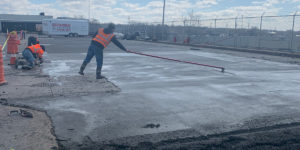HARD-CEM: How We Use It
Hello Concrete Enthusiasts!!! If you’re not an enthusiast, we hope to make you one!
By way of introduction: My name is Max Goodmanson (administrative assistant at Goodmanson Construction).
Our hope with this Blog is to fill you in on some of the technological aspects of the concrete industry and tell you how stuff works.
Our first ever Blog will be about Concrete Finishing.
HARD cem is engineered to provide concrete with superior hardness and improved durability for demanding construction projects.
Test results show that HARD-CEM can reduce abrasion loss by up to 66% compared to non-hardened concrete. Quite a coup for those of you running fork lifts over your warehouse floors every day!
HARD-CEM is a dry powdered material added to the concrete mix. It has the ability to enhance the integrity of the concrete mix, providing advantages in applications requiring enhanced hardness/abrasion resistance in industrial floors and Super-Flat Floors.
What is a Super-Flat Floor you ask?
Well… it is a floor that is SUPER FLAT!!! (Just teasing).
A Super-Flat floor is a floor that distribution centers, warehouses and production facilities benefit from due to the fact that they are smoother floors with less bumps and gradient between two points. GRADIENT=INCLINATION (slope).
Flat-Floor? No slope. This makes the use of forklift trucks more efficient, reducing operational costs.
HARD-CEM is a functional filler additive (not a chemical admixture).
Thank goodness!
HARD-CEM is added to a concrete surface using a bull float tool. It’s easy to use (for professionals, anyway)!
HARD-CEM is a very versatile additive as well, it’s a concrete hardener developed to enhance the integrity of air entrained and non-air entrained concretes. It’s unique in its ability to do that!
Now What’s Air Entrainment?
Concrete looks solid, but actually it’s porous. So that means little air bubbles (thankfully, if it’s well done, those air bubbles are tiny) are stuck in the concrete. Sometimes, we do that intentionally. Why would you do that? Isn’t that bad?
Not if you’ve got concrete subject to a freeze-thaw cycle! Think about it. If you’ve got a solid block of concrete with no bubbles in it to expand and contract, then it’s just going to split and crack. There’s just nowhere for that freeze-thaw expansion to go!
Let’s have a quick quiz.
When do you think you would use Air Entrained versus Non-Air Entrained Concrete?
Tick-Tock, Tick-Tock.
Give up?
Air Entrained Concrete is typically used outdoors (where temperatures vary and is subject to freeze-thaw.
Non-Air Entrained Concrete is used typically indoors where there is temperature control.
But HARD-CEM, thankfully, works with both kinds of surfaces. Like I said, versatile stuff!
We here at Goodmanson Construction (having been in business for 42 years) know that concrete performance depends on many variables such as concrete materials, batching/mixing, placing, finishing, weather conditions, etc…All of which we will cover in the weeks ahead.
We would like to thank you for attending my/our first ever blog. I really would like to know where that word came from.
We hope to see you all next week!!
If per chance we have raised some questions in your minds about HARD-CEM, the Concrete Industry or Goodmanson Construction, please feel free to let us know.


